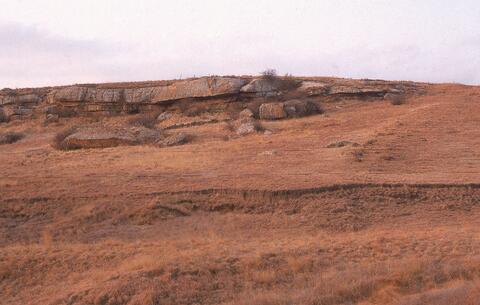Identity area
Reference code
Title
Date(s)
- 15/09/2000 (Creation)
Level of description
Extent and medium
Context area
Name of creator
Biographical history
Brief description of site: The RSA VHD1 rock shelter is bilobial and measures 19 m x 2.5 m and is between 1.2 m - 2.5 m high. T he site has a natural spring in its centre. A substantial stone wall that may date from the Boer-Basotho Wars or from early white settlers (c. 1840-1860) encloses the slopes below the site. The site faces south-west and may be described as relatively hidden, even though it is within a kilometre of the tar road.
The site has a surprising depth of archaeological deposit; up to 1 m thick in places (tested by 5 mm auger). The deposit has a hard capping and only a few crypto-crystalline silicate lithics (stone tools) were observed.The spring area has considerable ceramic, glass and metal debris from historic times (1820 CE onwards), The site looks to have been visited regularly in the past and there is little surface scatter though there are some hornfels and opaline lithics on the slope in front of the shelter, but few. There are at least 4 grinding patches and one area where metal has been whetted. There is a lot of hydrous ferrous oxide (2Fe2O3 3H2O) trapped in the shelter's rock strata.
Brief description of art: RSA VDH1 has two (Bushman / San and Korana) and possibly three (Sotho) macro rock art traditions represented as well as an exceptional degree of cross-cultural and cross temporal engagement with the art. There are at least 145 - motifs present in the shelter -109 of San authourship and the remaining 36 of Korana and/or Khoe origin. The ceiling 'paintings' could possibly be of Sotho origin, but are more likely Korana/Khoe.
Located in the South East end of the shelter is a striking, well-preserved 600+ year old panel representing a Medicine Dance (also known as a Trance dance). At least 9 human figures depicted in muted red paint derived from exotic ferric oxide participate. There are at least 13 flywhisks depicted. The flywhisk is known ethnographically to be associated exclusively with the Medicine Dance. Above this panel are at least 23 white and red eland (Taurotragus oryx). They form a 2.5 m x 1.0. With and on top of of these eland are white Korana finger paintings. There are at least two horses, one with a distinct rider. There are also 2 V-shaped motifs and numerous daubs. A large (San) eland has been outlined in white finger paint and at least two small antelope - probably Mountain Rhebuck (Redunca fulvorufula) - have been effaced with white smears. To the right another eland has had a white finger-painted dewlap added. The paintings on the western end of the shelter, beyond the natural spring, are not well preserved though animated human figures and large antelope are evident as well as some enigmatic lines. There are also streaks of white and light red ochre on the ceiling as well as a few geometric motifs. At the far eastern end of the shelter 2.3 m above present surface level is a panel of ochre finger-painted geometric motifs comprising vertical rows of fingerdots and square geometrics. Pigment removal: In at least seven instances pigment has been removed -quite deeply and in two instances with a metal instrument - from the forequarters and dewlaps of the eland paintings. Such removal of pigment differs from normal graffiti or 'vandalism' in its precision of purpose. Such removals are typically carried out by Bantu-speaking religious practitioners. Pigment is removed to cure illness emanating from malevolent sources and to ward off lighting. Pigment is considered to have potency on account of the San being acknowledged as people with special ritual powers. Significantly, pigment has not been removed indiscriminately - it has been removed only from eland and only from their forequarter/dewlap area.
Name of creator
Biographical history
Nationality: South African
Created by: willem
Created on: 11/03/2003
Name of creator
Biographical history
Repository
Archival history
Immediate source of acquisition or transfer
Content and structure area
Scope and content
Appraisal, destruction and scheduling
Accruals
System of arrangement
Conditions of access and use area
Conditions governing access
Conditions governing reproduction
Language of material
- English
Script of material
Language and script notes
Physical characteristics and technical requirements
Original size: 35mm

